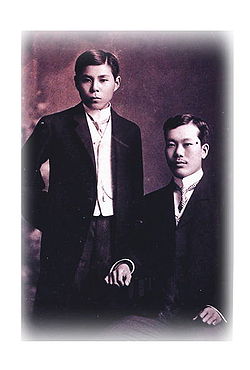- Cuong De
-
Cường Để
彊柢 Phan Boi Chau (right) with Prince Cường Để, circa 1907.
Phan Boi Chau (right) with Prince Cường Để, circa 1907.
Vietnamese name Quốc ngữ Cường Để Chữ nôm 彊柢 Prince Cường Để (born Nguyễn Phúc Đan (阮福單), 1882–1951) was an early 20th century Vietnamese revolutionary who, along with Phan Bội Châu, unsuccessfully tried to liberate Vietnam from French colonial occupation.
He was a royal relative of the Nguyễn Dynasty, and, according to the old rule of primogeniture, was the heir of the dynasty, directly issued from the line of first-born descendants of Emperor Gia Long and his son Prince Cảnh.[1] He was officially an "external marquis" (Ky Ngoai Hau), who used his royal lineage to gain the support of wealthy patriots, particularly in the south of Vietnam, to finance his independence movement.
He was involved in the 1905 Đông Du (Go East) movement, which sent Vietnamese students to study in Japan, and for being the nominal leader of the 1904 Reformation Society (Duy Tân Hội) and the 1911 Vietnam Restoration Organisation (Việt Nam Quang Phục Hội).
However he became controversial due to his later support of the Japanese occupation of Vietnam during World War II, which he hoped would liberate Vietnam from the French.
Notes
External links
- Phan Bội Châu and the Dông-Du Movement edited by Vinh Sinh of Yale University (PDF).

This biography of a member of an Asian royal house is a stub. You can help Wikipedia by expanding it. This Southeast Asian history-related article is a stub. You can help Wikipedia by expanding it.



